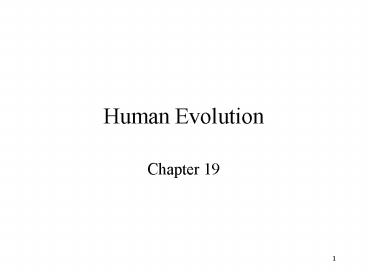Human Evolution PowerPoint PPT Presentation
Title: Human Evolution
1
Human Evolution
- Chapter 19
2
Human evolution
- Closest living relatives
- Fossil hominids (missing links)
- Origin and spread of Homo sapiens
3
Which species is the sister taxon toH. sapiens?
4
The phylogeny of apes as first proposed by Huxley
(1863) and universally accepted today (Fig. 19.1)
5
The phylogeny of apes based on immunological
distance as proposed by Sarich and Wilson (1967)
(Fig. 19.2)
6
Possible phylogenies of humans and the African
great apes (Fig. 19.3)
7
The phylogeny of mitochondrial cytochrome oxidase
II in humans and great apes (Ruvolo et al. 1994)
(Fig. 19.4)
8
Gene trees vs. species trees (Fig. 19.5)
9
Divergence times for the apes based upon a
variety of protein-coding genes (Stauffer et al.
2001) (Fig. 19.6)(heavy bars 1 SE light bars
95 CI)
10
Fossil hominids the recent ancestry of humans
- hominid is traditionally taken to mean any
species more closely related to humans than to
chimpanzees a bipedal member of the ape clade - The fossil evidence indicates that bipedality
evolved before increased brain size - Trends in hominid evolution
- Increase in brain size
- Increase in body size
- Vertical or flat face
- Tool use
11
Prominent hominid fossil species 1
- Autralopithecus afarensis (3.9 3.0 mya)
- East Africa, Lucy, Donald Johanson 1974, brain
size 400 - 500 cm3, females 3 7, males 4 7
4 11, evidence for bipedality comes from
skeletons and fossilized footprints (Laetoli,
Tanzania, 3.6 mya) - Australopithecus africanus (2.8 2.4 mya)
- South Africa, Taung child, Raymond Dart 1924,
similar in size to A. afarensis. A. africanus
and A. afarensis are grouped together as gracile
australopithecines
12
Prominent hominid fossil species 2
- Autralopithecus (Paranthropus) boisei (2.3 1.4
mya) - Australopithecus (Paranthropus) robustus (2.0
1.0 mya) - East Africa, A. boisei and A. robustus are
grouped together as robust australopithecines,
brain slightly larger than gracile
australopithecines, large teeth, robust jaws,
massive jaw muscles, possibly tool users
13
Prominent hominid fossil species 3
- Homo habilis (1.9 1.6 mya)
- Homo rudolfensis (2.4 1.8 mya)
- East Africa, probable tool users, brain 510 775
cm3, some would assign both to Australopithecus - Homo ergaster (1.8 1.5 mya)
- East Africa, brain 850 cm3, some refer to this
species as African Homo erectus to distinguish
from H. erectus in Asia and Europe
14
Oldowan stone tools from Hadar, Ethiopia (Kimbel
et al. 1996) (Fig. 19.27)
2.3 million years old
15
Prominent hominid fossil species 4
- Homo erectus (1.8 0.4 mya)
- Africa, Asia, Europe, first hominid outside of
Africa, Java Man, Peking Man - Homo heidelbergensis (0.6 0.2 mya)
- Africa, descendant of H. ergaster? Separate
species or transitional form between H.
ergaster/erectus and H. sapiens? - Homo neanderthalensis (0.3 0.03 mya)
- Middle East, Europe, Separate species or
transitional form between H. ergaster/erectus and
H. sapiens? Some classify Neanderthals as
archaic H. sapiens
16
Homo sapiens
- First fossils of anatomically modern humans about
100,000 years old in Africa and Israel, and
somewhat later in Europe and Asia - Originated from some population or populations of
the H. ergaster/erectus lineage, contemporaneous
with Neanderthals in Middle East and Europe
17
Summary of the fossil evidence of the recent
ancestry of humans (Wood 2002) (Fig. 19.15)
18
Brain size vs. body size in a variety of hominids
and great apes (Fig. 19.31)
19
Cladogram and phylogeny of Homo sapiens and its
recent ancestors and extinct relatives (Fig.
19.16)
20
Hypotheses concerning the transition from Homo
ergaster/erectus to Homo sapiens (Fig. 19.17)
21
Genetic diversity of humans vs. African great
apes based on mtDNA sequence differences between
all possible pairs of individuals (Gagneux 1999)
(Fig. 19.18)
22
Evidence of geographic structure in living human
populations (Rosenberg et al. 2002) (Fig. 19.19)
Based on 377 microsatellite loci in 1,056
individuals from 52 populations
23
Phylogenetic predictions of the African
replacement model vs. the multiregional evolution
model (Leiberman 1995) (Fig. 19.20)
24
mtDNA phylogeny of 3 Neanderthals and several
hundred modern humans (Fig. 19.21)
25
An evolutionary tree of complete mtDNAs of 53
humans(Ingman et al. 2000) (Fig. 19.22)
26
Divergence times of species trees, population
trees, and gene trees (Fig. 19.23)
27
Phylogenetic tree for 14 human populations based
on allele frequencies at 30 microsatellite loci
(Bowcock et al. 1994) (Fig. 19.21)
28
Genetic diversity at a single locus among the
people of seven geographic regions (Tishkoff et
al. 1996) (Fig. 19.25)

